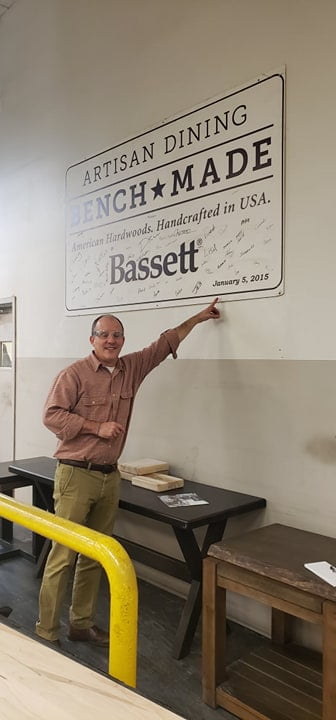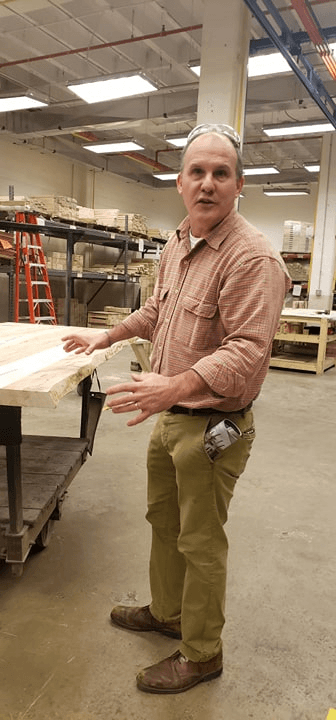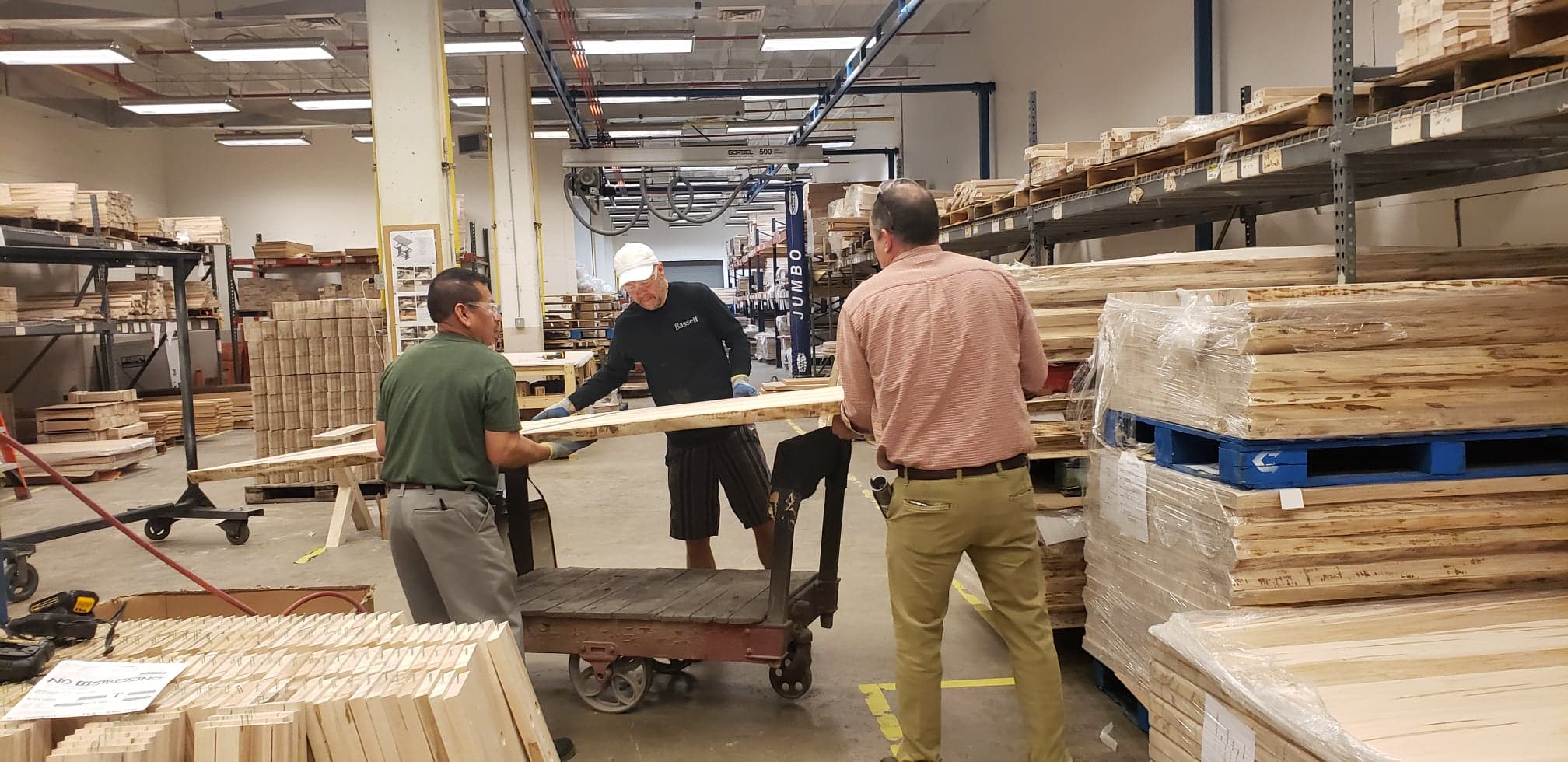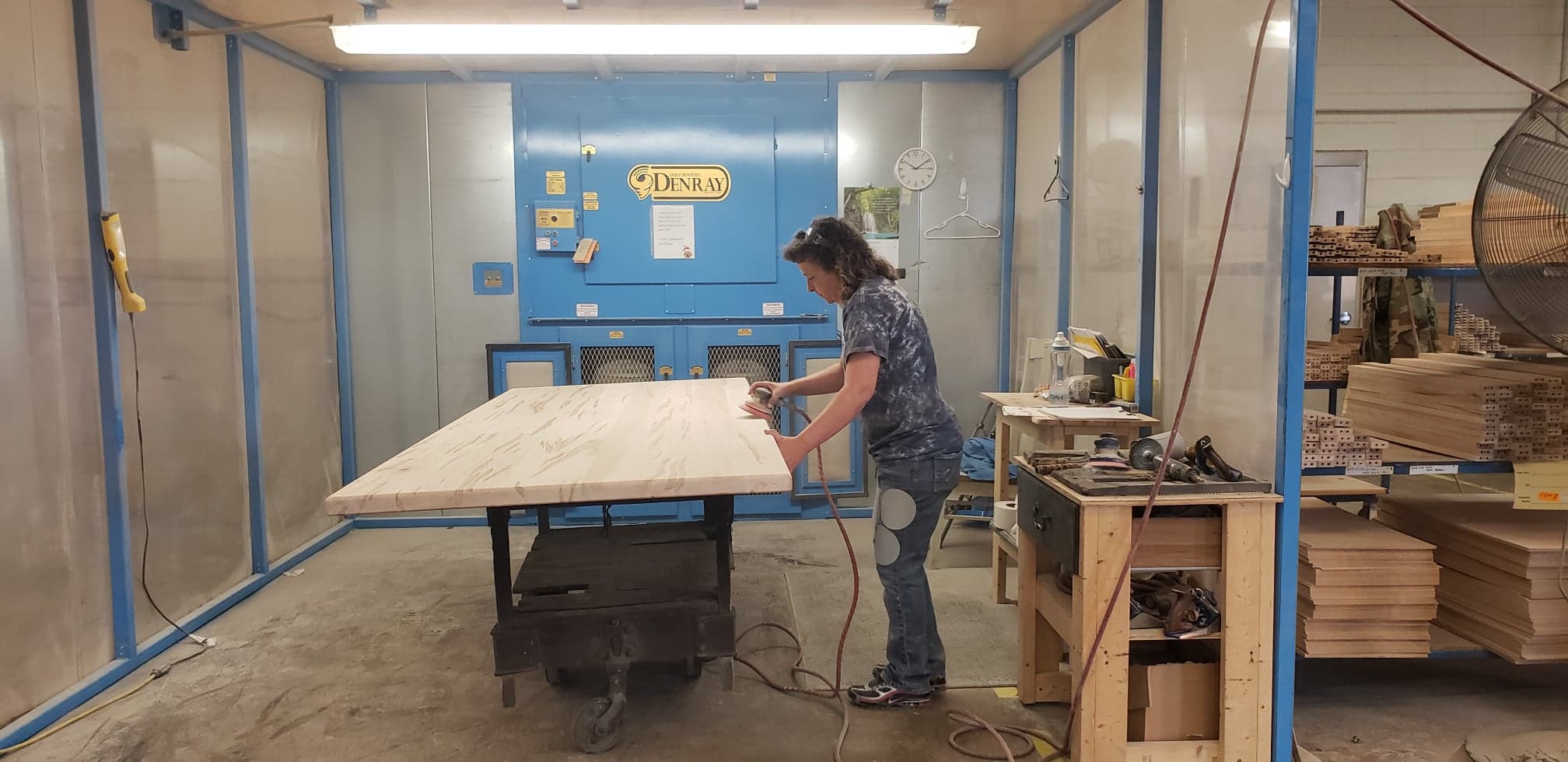
By Debbie Hall
Bassett Furniture Industries Inc. in January celebrated the fifth anniversary of its Bench Made facility in the traditional fashion—with a sheet cake and employees with at least a year of service affixing their signatures to a sign inside the building.
The Bench Made facility in Bassett also helped drive an increase in the production and sales of domestically produced furniture, according to Jeb Bassett, COO of Bassett Furniture Industries, Inc. and J. Carter Underwood, the company’s vice president of domestic wood manufacturing.
In January, which is the most recent data available, 80 percent of the products were domestically produced, according to Bassett.
The products are made in either the Bench Made facility in Bassett, the Martinsville Table facility in the Patriot Centre industrial park or in the company’s facilities in Newton, N.C. and Grand Prairie, Texas, according to Underwood.
Bench Made is among the Bassett lines that will be showcased at Fast Track 2020, on March 3 and 4 in the former Compton Wood Products facility in the Patriot Centre.
In keeping with the “Best of the Decade” theme of Fast Track 2020, “we feel like Bench Made is the best story of the decade,” Underwood said.
In 2019, Bench Made product lines, including dining, bedroom, occasional tables and entertainment categories, amounted to $23 million in wholesale sales. This year, that figure is expected to be $23 to $25 million, Bassett said.
At one point, Bassett’s domestically made lines dipped to about 50 percent of the company’s production, Bassett said. The remaining half was produced offshore.
“We made a lot of tough decisions in the late 1990s and early 2000s with the whole globalization of the furniture industry. What made Bassett different from most of the other furniture companies was we were proceeding with our own retail distribution network, Bassett Home Furnishings retail,” Bassett said.
Also, customers were given the option of customizing products, whether in upholstered furniture or casual dining. “We gave the consumer a lot of choices, where they could design their own” furniture, Bassett said. Among those options were custom finishes, fabrics and color options, he said.
The current philosophy also is “unique compared to the furniture factories of the ’50s, ’60s, ’70s, ’80s and ’90s,” Underwood said. In those decades, he said, the philosophy was to mass produce big collections such as Eden House and Grove Park.
“Everything was match-y, match-y,” and when a production run was created, employees generally would run one type of furniture – nightstands, for instance – for three to four weeks or longer, Underwood said.
If the sales projections were off and suppliers sold out of a particular piece, Underwood said it could be months before production of that item cycled back around.
“In the 90s, when a lot of production was going to Asia,” the Newton facility hit on the customization concept, Underwood said. “I think they figured out early on the best way to compensate was to offer custom products. If you could offer something unique, it gave you a reason to stay in the game.”
In 2014, Rob Spilman, CEO and chairman of the company, posed a question:

“What is the furniture version of ‘farm to table, craft beer and small batch bourbon?’ What would really resonate with the consumer,” Bassett recalled. “So, we started playing around with ideas and created a few samples of product with basic carpenter tools. Everything was (made from) solid hardwood.”
That was the genesis of Bench Made furniture.
Initial products included a 42-inches wide rectangular dining room table that could be customized in length from 72- to 108-inches; a round dining room table that was available in 60-inch and a 72-inch diameter, three different styles of chairs and a hunt board, “a simply made piece” with a name derived from a bygone era, Bassett said. He explained that when originally used, game was prepared and/or served on top of hunt boards.
Hardwoods native to the Appalachian region – red leaf maple and a mixture of red oak and white oak — were used to create the furniture, “and we distributed it through our network” of retail stores, he said.
The products debuted at the fall 2014 market and “were very successful,” Bassett said. “We created a manufacturing facility in 90 days. We took advantage of the current environmental permits that we had maintained” and manufacturing operations began in the new facility on Jan. 5, 2015.
Currently, 50 people are employed there, Bassett said.
Underwood noted the facility was designed in a linear footprint. Products enter on one end before they go through the various manufacturing processes, ending as a finished product on the other end of the building.
In addition to the design of the facility, “every single thing we’re making is a custom order,” Underwood said. He explained that the orders for furniture production come from the company’s retail stores and/or their affiliates.
Customers visiting those stores select, for instance, the style of table they want, “then, they pick the base, whether it has legs, a trestle base or a cross buck base,” Underwood said. Sixteen finishes also are available.

“By the time the table options, base options and colors are expanded, there are hundreds of thousands of different combinations we make” according to the consumer’s wishes, he said.
“Our claim to fame is” that the finished product is delivered to the customer’s home within 30 days, Underwood said.
Even in that time frame, employees who include craftsmen and artisans, work to individualize each piece to the customer’s specifications, Underwood said. When pieces are completed, an employee signs his name and date on the piece. That information, along with other identifying data from the order, is put into a computer, along with the sequential manufacturer’s number.
Employees prepared table number 26,251 for shipping on Feb. 26.
“We’ve shown growth over the years. Our product line has been expanded” and even more customization options have been added, Bassett said, and explained that now, dining room tables may be built up to 126 inches in length. Additionally, the custom lines were expanded to include bedroom furniture, occasional tables and home entertainment.

The company also is a good steward. When certain pieces are sold, for instance for each dining room table, cocktail table, bed or home entertainment piece, the company plants two trees, Bassett said.
“We plant those in the Appalachian region, where the raw material is harvested,” he said, adding most of the areas are within a half day drive of the company’s headquarters. “Last year, we planted 22,000 trees. Over the course of the next five years, we will plant 84,440 trees, mixed hardwoods.”
“We’re very proud” of Bassett’s accomplishments, Underwood said. “Fifteen years ago, it was a different story, but now, we’re very proud.”




